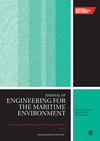Effect of biomimetic fish scale structure on the drag reduction performance of Clark-Y hydrofoil
IF 1.5
4区 工程技术
Q3 ENGINEERING, MARINE
Proceedings of the Institution of Mechanical Engineers, Part M: Journal of Engineering for the Maritime Environment
Pub Date : 2024-01-29
DOI:10.1177/14750902241228153
引用次数: 0
Abstract
A hydrofoil is a basic shape of fluid machinery blades, and its drag reduction performance is an important reference index in the field of fluid transportation. When fluid flows around a hydrofoil, it generates friction drag and pressure drag, greatly reducing the hydrofoil’s hydraulic performance. This study designs a bionic drag reduction structure by arranging fish scales on a Clark-Y hydrofoil. The overlapping size, thickness, and coverage area of fish scales are taken as design parameters, and the optimal design scheme is attained by using the Taguchi method. Large eddy simulation is used to numerically simulate various schemes. Results show that when the overlapping size O is 2.00 mm, the thickness h is 0.36 mm, the initial position x/C of the fish scale covering is 0 (where C is the chord length of the hydrofoil), and the hydrofoil exhibits excellent drag reduction performance. The total drag reduction rate of the hydrofoil is up to 35.15%, and the drag reduction rate of friction drag and pressure drag is up to 39.56% and 25.64%, respectively. The lift–drag ratio of the hydrofoil increases by 18.04%. The bionic fish scale structure effectively inhibits turbulence, thereby reducing the drag caused by the transformation of laminar flow to turbulence.仿生鱼鳞结构对克拉克-Y 水翼减阻性能的影响
水翼是流体机械叶片的一种基本形状,其减阻性能是流体运输领域的一项重要参考指标。当流体围绕水翼流动时,会产生摩擦阻力和压力阻力,大大降低水翼的水力性能。本研究通过在克拉克-Y 型水翼上排列鱼鳞,设计了一种仿生减阻结构。以鱼鳞的重叠尺寸、厚度和覆盖面积为设计参数,采用田口方法获得最佳设计方案。采用大涡模拟对各种方案进行数值模拟。结果表明,当重叠尺寸 O 为 2.00 mm、厚度 h 为 0.36 mm、鱼鳞覆盖的初始位置 x/C 为 0(其中 C 为水翼的弦长)时,水翼表现出优异的减阻性能。水翼的总阻力降低率高达 35.15%,摩擦阻力和压力阻力的阻力降低率分别高达 39.56% 和 25.64%。水翼的升阻比提高了 18.04%。仿生鱼鳞结构有效地抑制了湍流,从而减少了层流转化为湍流时产生的阻力。
本文章由计算机程序翻译,如有差异,请以英文原文为准。
求助全文
约1分钟内获得全文
求助全文
来源期刊

CiteScore
3.90
自引率
11.10%
发文量
77
审稿时长
>12 weeks
期刊介绍:
The Journal of Engineering for the Maritime Environment is concerned with the design, production and operation of engineering artefacts for the maritime environment. The journal straddles the traditional boundaries of naval architecture, marine engineering, offshore/ocean engineering, coastal engineering and port engineering.
 求助内容:
求助内容: 应助结果提醒方式:
应助结果提醒方式:


